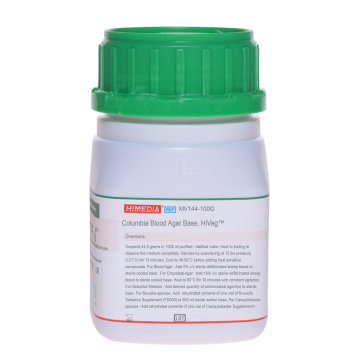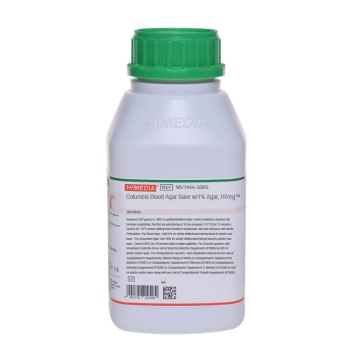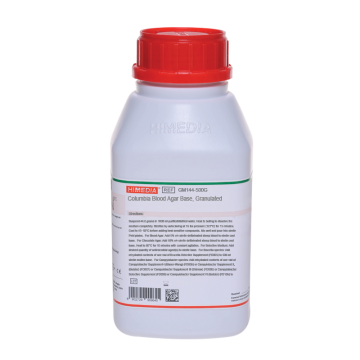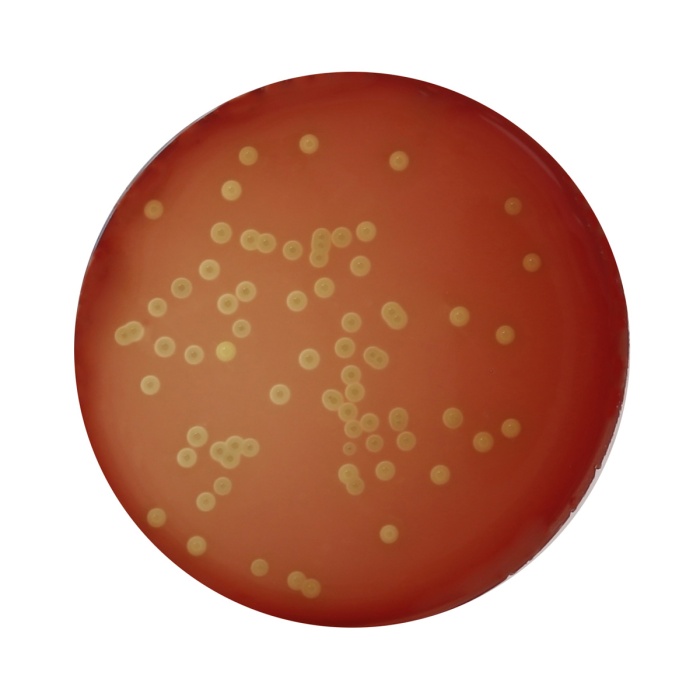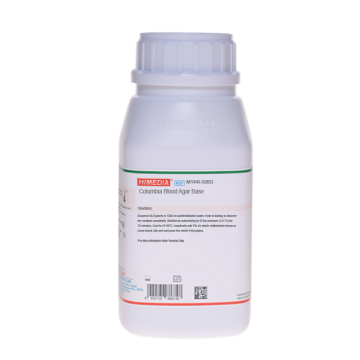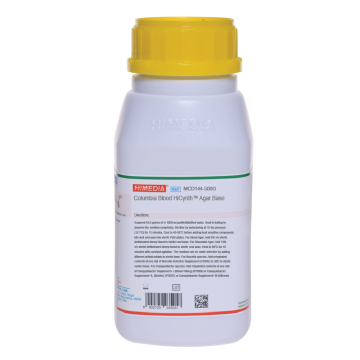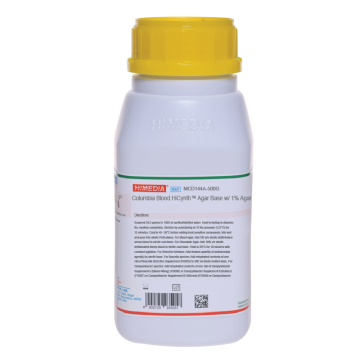 Your enquiry has been submitted
Your enquiry has been submitted
Columbia Blood Agar Base w/ 1% Agar
Intended Use
Used with blood for isolation and cultivation of fastidious bacteria.
Composition
| Ingredients | g/L |
|---|---|
| Peptone special | 23.000 |
| Corn starch | 1.000 |
| Sodium chloride | 5.000 |
| Agar | 10.000 |
Final pH (at 25°C): 7.3±0.2
Formula adjusted, standardized to suit performance parameters
Directions
Suspend 39.0 grams in 1000 ml purified / distilled water. Heat to boiling to dissolve the medium completely. Sterilize by autoclaving at 15 lbs pressure (121°C) for 15 minutes. Cool to 45-50°C before adding heat sensitive compounds.
For Blood Agar: Add 5% v/v sterile defibrinated sheep blood to sterile cool base.
For Chocolate Agar: Add 10% v/v sterile defibrinated sheep blood to sterile cool base. Heat to 80°C for 10 minutes with constant agitation. The medium can be made selective by adding different antimicrobials to sterile base.
For Brucella species: Add rehydrated contents of 1 vial of NPBCVN Selective Supplement (FD005) to 500 ml sterile molten base.
For Campylobacter species: Add rehydrated contents of 1 vial of Blaser-Wang Selective Supplement (Blaser-Wang) (FD006) or Butzler Selective Supplement (Butzler) (FD007) or Skirrow Selective Supplement (FD008) or VTCA Selective Supplement (FD090) or Butzler VI Selective Supplement (FD106) to 500 ml sterile molten base along with rehydrated contents of 1 vial of Minerals Growth Supplement(FD009).
For Gardnerella species: Add rehydrated contents of 1 vial of GNA Selective Supplement(FD056) to 500 ml sterile molten base.
For Cocci: Add rehydrated contents of 1 vial of NC Selective Supplement (FD030) or NNP Selective Supplement (FD031) or CO Selective Supplement (FD119) to 500 ml sterile molten base.
Principle And Interpretation
Columbia Blood Agar Base is a general-purpose nutritious agar base formulated by Ellner et al (1) in 1966; it is further enriched by the addition of sterile blood. Traditionally blood agar bases have incorporated either casein hydrolysate to give rapid production of large colonies or meat infusion to give defined hemolytic reactions. Columbia Agar Base combines both to give an improved all round performance. This medium with the added special peptone supports rapid and luxuriant growth of fastidious and nonfastidious organisms. Also, this medium promotes typical colonial morphology; better pigment production and more sharply defined haemolytic reactions. Columbia Agar Base is used as the base for the media containing blood and for selective media formulations in which different combinations of antimicrobial agents are used as additives. Fildes found that Nutrient Agar supplemented with a digest of sheep blood supplied both of these factors and the medium would support the growth of H. influenzae (2,3). The inclusion of bacitracin makes the enriched Columbia Agar Medium selective for the isolation of Haemophilus species from clinical specimens, especially from upper respiratory tract (4). Columbia Blood Agar Base w/ 1% Agar is used as a base for preparing media containing blood and for selective media formulations in which different combinations of antimicrobial agents are used as additives. Corn starch serves as an energy source and also neutralizes toxic metabolites. Sheep blood permits the detection of haemolysis and also provides heme (X factor) which is required for the growth of many bacteria. However it is devoid of V factor (Nicotinamide adenine dinucleotide) and hence Haemophilus influenzae which needs both the X and V factors, will not grow on this medium. As this medium has a relatively high carbohydrate content, beta-haemolytic Streptococci may exhibit a greenish haemolytic reaction which may be mistaken for the alpha haemolysis. Carry out confirmatory tests of all the colonies. Columbia Agar Base with added sterile serum provides an efficient medium for Corynebacterium diphtheriae virulence test medium.
After following the established technique for C. diphtheriae, lines of toxin-antitoxin precipitation are clearly visible in 48 hours. Many pathogens require carbon dioxide; therefore, plates may be incubated in an atmosphere containing approximately 3-10% CO2. Precaution: Brucella cultures are highly infective and must be handled carefully; incubate in 5-10% CO2. Campylobacter species are best grown at 42°C in a microaerophillic atmosphere. Plates with Gardenerella supplements should be incubated at 35°C for 48 hours containing 7% CO2 (5).
Type of specimen
Clinical samples: Respiratory exudates, skin or wound lesions, faeces, etc.; Food samples
Specimen Collection and Handling
For food samples follow appropriate techniques for handling specimens as per established guidelines (6).
For clinical samples follow appropriate techniques for handling specimens as per established guidelines (7,8).
After use, contaminated materials must be sterilized by autoclaving before discarding.
Warning and Precautions
In Vitro diagnostic use. For professional use only. Read the label before opening the container. Wear protective gloves/ protective clothing/eye protection/face protection. Follow good microbiological lab practices while handling specimens and culture. Standard precautions as per established guidelines should be followed while handling clinical specimens. Safety guidelines may be referred in individual safety data sheets.
Limitations
- As this medium have a relatively high carbohydrate content, beta-haemolytic Streptococci may exhibit a greenish haemolytic reaction which may be mistaken for the alpha haemolysis.
- Individual organisms differ in their growth requirement and may show variable growth patterns on the medium.
- Each lot of the medium has been tested for the organisms specified on the COA. It is recommended to users to validate the medium for any specific microorganism other than mentioned in the COA based on the user's unique requirement.
- Further biochemical and serological testing is required for complete identification.
Performance and Evaluation
Performance of the medium is expected when used as per the direction on the label within the expiry period when stored at recommended temperature.
Quality Control
Appearance: Cream to yellow homogeneous free flowing powder
Gelling: Firm, comparable with 1.0% Agar gel.
Colour and Clarity of prepared medium: Basal medium: Light amber coloured clear to slightly opalescent gel. After addition of 5% v/v sterile defirinated blood: Cherry red coloured opaque gel forms in Petri plates
Reaction: Reaction of 3.9% w/v aqueous solution at 25°C. pH: 7.3±0.2
pH: 7.10-7.50
Cultural Response
Cultural characteristics observed with added 5% v/v defibrinated blood, after an incubation at 35-37°C for 40-48 hrs.
| Organism | Inoculum (CFU) | Growth | Recovery | Haemolysis |
|---|---|---|---|---|
| Neisseria meningitidis ATCC 13090 | 50-100 | luxuriant | >=70% | none |
| Staphylococcus aureus subsp. aureus ATCC 25923 (00034*) | 50-100 | luxuriant | >=70% | beta / gamma |
| Staphylococcus aureus subsp. aureus ATCC 6538 (00032*) | 50-100 | luxuriant | >=70% | beta/gamma |
| Staphylococcus epidermidis ATCC 12228 (00036*) | 50-100 | luxuriant | >=70% | gamma |
| Streptococcus pneumoniae ATCC 6303 | 50-100 | luxuriant | >=70% | alpha |
| Streptococcus pyogenes ATCC 19615 | 50-100 | luxuriant | >=70% | beta |
Key: (*) Corresponding WDCM numbers.
Storage and Shelf Life
Store between 10-30°C in a tightly closed container and the prepared medium at 2-8°C. Use before expiry date on the label.
On opening, product should be properly stored dry, after tightly capping the bottle in order to prevent lump formation due to the hygroscopic nature of the product. Improper storage of the product may lead to lump formation. Store in dry ventilated area protected from extremes of temperature and sources of ignition. Seal the container tightly after use. Product performance is best if used within stated expiry period.
Disposal
User must ensure safe disposal by autoclaving and/or incineration of used or unusable preparations of this product. Follow established laboratory procedures in disposing of infectious materials and material that comes into contact with clinical sample must be decontaminated and disposed of in accordance with current laboratory techniques (7,8).
References
- Ellner P. P., Stoessel C. J., Drakeford E. and Vasi F., 1966, Am. J. Clin. Pathol., 45:502.
- Fildes P., 1920, Br. J. Exp. Pathol., 1:129.
- Fildes P., 1921, Br. J. Exp. Pathol., 2:16.
- Chapin K. C. and Doern G. V., 1983, J. Clin. Microbiol., 17:1163.
- Bailey R. K., Voss J. L. and Smith R. F., 1979, J. Clin. Microbiol., 9; 65-71
- Salfinger Y., and Tortorello M.L., 2015, Compendium of Methods for the Microbiological Examination of Foods, 5th Ed., American Public Health Association, Washington, D.C.
- Isenberg, H.D. Clinical Microbiology Procedures Handbook 2nd Edition.
- Jorgensen, J.H., Pfaller, M.A., Carroll, K.C., Funke, G., Landry, M.L., Richter, S.S and Warnock., D.W. (2015) Manual of Clinical Microbiology, 11th Edition. Vol. 1.
| Product Name | Columbia Blood Agar Base w/ 1% Agar |
|---|---|
| SKU | M144A |
| Product Type | Regular |
| Physical Form | Powder |
| Origin | Animal |
| Packaging type | HDPE |
| References | 1. Ellner P. P., Stoessel C. J., Drakeford E. and Vasi F., 1966, Am. J. Clin. Pathol., 45:502. 2.Fildes P., 1920, Br. J. Exp. Pathol., 1:129. 3.Fildes P., 1921, Br. J. Exp. Pathol., 2:16. 4.Chapin K. C. and Doern G. V., 1983, J. Clin. Microbiol., 17:1163. 5.Bailey R. K., Voss J. L. and Smith R. F., 1979, J. Clin. Microbiol., 9 ; 65-71 6.Salfinger Y., and Tortorello M.L. Fifth (Ed.), 2015, Compendium of Methods for the Microbiological Examination ofFoods, 5th Ed., American Public Health Association, Washington, D.C. 7.Baird R.B., Eaton A.D., and Rice E.W., (Eds.), 2015, Standard Methods for the Examination of Water andWastewater, 23rd ed., APHA, Washington, D.C. 8.Wehr H. M. and Frank J. H., 2004, Standard Methods for the Microbiological Examination of Dairy Products, 17th Ed.,APHA Inc., Washington, D.C. 10.Jorgensen,J.H., Pfaller , M.A., Carroll, K.C., Funke, G., Landry, M.L., Richter, S.S and Warnock., D.W. (2015) Manualof Clinical Microbiology, 11th Edition. Vol. 1. |
| Customized Product Available | No |




